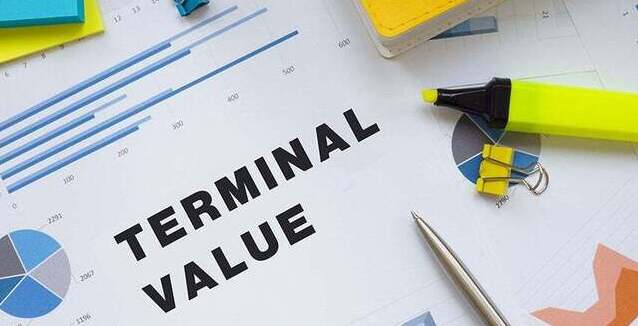
What Is Terminal Value
Terminal Value is the value of cash flows post the forecast period and generally forms a large part of the valuation of a company.
The prime factors affecting the terminal value are the Net Operating Profit After Tax (NOPAT), Investment Rate (Fixed Assets and Net Working Capital) and Income Tax Rate in the Target year (Last Year of the Forecast Period) and Risk-Free Rate, Inflation, Terminal Growth Rate, Debt Equity Ratio, Income Tax Rate, and Discount Rate (WACC) in the Terminal Period.
As mentioned earlier in this section, the free cash flows over the forecast period represent the first part of a company’s value. The Discounted Cash Flow Model values companies as a going concern, thus a company continues to have value post the forecast period. This part of the cash flow (post-forecast period) is called Terminal Value.
Why is a Terminal Value Used
Terminal value is used in financial modelling and valuation analysis to capture the value of a company or business beyond the explicit forecast period, which is typically a few years. In a discounted cash flow (DCF) analysis, the explicit forecast period usually covers a limited number of years, during which financial projections are made based on expected future cash flows.
However, businesses are expected to continue operating beyond the forecast period, and their value should be considered beyond those years. The terminal value accounts for the cash flows that occur after the explicit forecast period and provides a way to capture the long-term value of the company.
There are several reasons why a terminal value is used:
- Practicality: It is often impractical to forecast cash flows for an infinite number of years. Using a terminal value allows analysts to capture the value of the business beyond the forecast horizon without having to project cash flows indefinitely.
- Stability Assumption: The terminal value assumes that the business will reach a stable growth phase after the explicit forecast period. It is based on the premise that the company will grow at a more sustainable rate in perpetuity, representing its long-term growth potential.
- Simplification: By applying a terminal value, the DCF analysis becomes more straightforward and manageable. It reduces the complexity of projecting cash flows for an extended period and provides a reasonable approximation of the company's ongoing value.
Which are methods to compute Terminal Value
There are several methods to compute the terminal value in a discounted cash flow (DCF) analysis. The terminal value represents the value of a company beyond the explicit forecast period. Some common methods to calculate terminal value include:
- Perpetuity Growth Method (Gordon Growth Model): This method assumes that the company's free cash flows will grow at a constant rate indefinitely beyond the forecast period. The perpetuity growth rate is typically based on the assumption of the company's long-term sustainable growth rate. The formula for the perpetuity growth model is: Terminal Value = FCFn * (1 + g) / (r - g), where FCFn is the free cash flow in the last year of the explicit forecast period, g is the perpetuity growth rate, and r is the discount rate.
- Exit Multiple Method: In this approach, a multiple is applied to a relevant financial metric (such as EBITDA, EPS, revenue, or free cash flow) to estimate the terminal value. The multiple is based on comparable companies in the industry or historical transaction multiples. The formula for the exit multiple method is: Terminal Value = Terminal Multiple * Relevant Financial Metric.
- Liquidation Value Method: This method estimates the terminal value by assuming the company is liquidated at the end of the forecast period. It calculates the net present value of the company's assets after settling its liabilities.
Each method has its advantages and limitations, and the choice of the terminal value method should be based on the specific characteristics of the company being valued, the industry it operates in, and the quality of available data. It's essential to use reasonable and well-founded assumptions when applying any of these methods to ensure the accuracy and reliability of the valuation.
What is Perpetual Growth DCF Terminal Value Formula
The Perpetual Growth DCF Terminal Value Model is a geometric series that computes the value of a series of growing future cash flows. It is a derivation of the dividend discount model. The Free Cash flows of the Target Year are multiplied by (1 + Terminal Growth Rate) to arrive at the first year post the forecast period. This value is then divided by the Weighted Average Cost of Capital (WACC), less the Terminal Growth Rate (Cost of Capital – Terminal Growth Rate).
The formula for computing the terminal value is as follows:
| Terminal Value | = | FFCT x (1+ Terminal Growth Rate) |
| WACC less Terminal Growth Rate |
Note:
- FFCT is the Free Cash Flows in the target year (last year of the forecast period), adjusted for Income Tax assumed in the Terminal Period.
- Estimating, the target year Operating Profit After Tax, Income Tax, and Investment Rate (Fixed Plus NWC) thus forms a crucial parameter in arriving at a valuation.
Once we compute the terminal value, we need to multiply this with the discount factor of the last year of the forecast period to arrive at the present value of the terminal value
Present Value of Terminal Value = Terminal Value x Discount Factor at the end of Forecast Period
Terminal Growth Rate
The Terminal Growth builds in the inflationary growth plus real growth (a steady state) There are three ways in which one may grow the Free Cash Flows during the Terminal Period:
- The Cash Flows to Grow at Inflationary Growth Rate plus Real Growth .
- The Cash Flows to Grow only at the Expected Inflation Rate.
- The Cash Flows remain constant with zero growth.
The Inflationary Growth could be in line with the Long-Term Inflation assumed. This essentially is the pricing power of the company and its ability to keep up with inflation. In the very long term, one should check the history of Inflation of the Currency for a very long term
The Real Growth expected into perpetuity should consider the Country’s GDP Growth Rate, Industry Growth Rate, and the trend of the World GDP Growth Rate.
You will need to ensure that the Terminal Growth is not greater than the Weighted Average Cost of Capital (WACC) of the Company.
Now that we have defined Terminal Growth, we need to define the WACC during the Terminal Period.
WACC during Terminal Period
We require the following inputs to compute the WACC during Terminal Period:
Expected Inflation Rate
The Expected Inflation Rate should be inflation expectations for the Terminal Period (into perpetuity). The Expected Inflation Rate is for the currency in which the valuation is conducted. Generally, the Risk-Free Rate assumed should incorporate the Expected Inflation for the Terminal Period.
The Inflation here will be a component in computing the Cost of Debt and Cost of Equity during the Terminal Period.
Risk-Free Rate
The Risk-Free Rate is the expected government bond yield for the Terminal Period. A risk-free Rate is defined as an Expected Inflation Rate + Real Interest Rate. Thus, this Risk-Free Rate should incorporate the Inflation Rate.
Income Tax
We will require the Income Tax Rate expected during the Terminal Period. This should be the Expected Marginal Income Tax Rate in the long term that the company is likely to incur during the Terminal Period (Post Forecast Period).
In case the Income Tax during the Terminal Period is assumed to be different than assumed during the Forecast Period then one needs to adjust this with Income Tax assumed during the Terminal Period and recompute the Free Cash Flow for the Target Year (Last Year of the forecast Period).
Debt Equity Ratio
This is the expected Debt Equity Ratio during the Terminal Period.
Cost of Debt during the Terminal Period
This is the Pre-Tax Cost of Debt expected during the Terminal Period. The Cost of Debt should be the Cost of Debt of the Currency in which the company is being valued. The Cost of Debt during the Terminal Period should be consistent with the assumptions of the Expected Inflation Rate and Risk-Free Rate entered during the Terminal Period. The user should add the default spread to the Risk-Free Rate assumed during the Terminal Period to arrive at the Pre-tax Cost of Debt.
Cost of Equity during the Terminal Period
We will require the Cost of Equity for the Terminal Period. This can be assumed based on Capital Asset Pricing Model (CAPM) or any other model or could just be the implicit return rate of the market or as investors require.
What is the Exit Multiple DCF Terminal Value Formula
The Exit Multiple DCF Terminal Value formula is used in the Discounted Cash Flow (DCF) valuation method to estimate the value of a business or investment at the end of a projected period. The terminal value represents the value beyond the projected period and is typically determined using a multiple of a financial metric, such as EBITDA (Earnings Before Interest, Taxes, Depreciation, and Amortization) or Earnings Per Share, Revenue, Free cash flow Multiple.
The formula for calculating the Exit Multiple DCF Terminal Value is as follows:
Exit Multiple DCF Terminal Value = Terminal Year Metric * Exit Multiple
Where:
Terminal Year Metric: This is a financial metric (such as EBITDA or EPS) that is projected for the last year of the explicit forecast period
Exit Multiple: This is a chosen multiple that is applied to the Terminal Year Metric to estimate the terminal value. The multiple is often derived from comparable company analysis or market data
Once the Exit Multiple DCF Terminal Value is calculated, it is then discounted back to the present value using the discount rate computed for Terminal Period cash flows. This discounted terminal value is added to the present value of the projected cash flows to arrive at the total estimated enterprise value.
It's important to note that determining the appropriate exit multiple and selecting the right terminal year metric require careful consideration and analysis. Sensitivity analysis and consideration of industry and market trends are also important to ensure the accuracy of the DCF valuation.
Example of a Valuation Model
Computing Terminal Value
We now compute the present terminal value for Company X. The following important variables are summarized below:
Summary of Variable for Computing Terminal Value and WACC during Terminal Period.
- Forecast Period is 5 Years
- Free Cash Flows in the 5th Year is 125
- Income Tax is assumed to be 25%
- The Expected Inflation Rate during the Terminal Period is assumed to be 2%
- Risk-Free Rate during the Terminal Period is assumed to be 2.25%
- Cost of Debt – Pre-Tax is assumed to be 4.5%
- Debt Equity Ratio is expected to be 25% Debt and 75% Equity
- Expected Market Returns are assumed at 8.9% (2% Inflation Plus 6.9% Expected Return over Inflation)z
- Beta is assumed at 0.75
- The Cost of Equity computed comes to 7.24%
- Post Tax Cost of Debt computed comes to 3.375%
- The Cost of Capital (WACC) computed comes to 6.272%
- The Discount Factor in Year Five is 0.639
- Inflationary Growth is assumed at 2%
- Real Growth is assumed at 2%
- Terminal Growth computed (Inflationary plus Real Growth Rate) is 4%
Computation of Terminal Value
Thus, computing the terminal value by applying the following formulae:
| Terminal Value | = | FFCT x (1+ Terminal Growth Rate) |
| WACC less Terminal Growth Rate |
| Terminal Value | = | 125 x (1+4%) | = | 5772.15 |
| (6.272% - 4%) |
PV of Terminal Value = 5772x 0.639 (Discount Factor in 5th Year) = 3656
The Present Value of Terminal Value needs to be added to PV of Operating Cash Flows to arrive at the enterprise value.
Key Points

- Terminal value (TV) establishes a company's value beyond a predicted timeframe, often spanning five to ten years.
- Discounted cash flow model (DCF) is employed by analysts to compute a business's overall value, relying on both the forecast period and terminal value.
- Two primary techniques for terminal value computation are perpetual growth (Gordon Growth Model) and exit multiple.
- The perpetual growth approach anticipates consistent perpetual cash flows, whereas the exit multiple method envisions the eventual sale of the business.
Frequently Asked Questions

Why Do We Need to Know the Terminal Value of a Business?
Understanding the terminal value of a business is crucial for several reasons:
- Long-Term Perspective: Terminal value accounts for cash flows beyond the forecast period, allowing us to consider the asset's or business's value in the long term or indefinitely.
- Investment Decision: Terminal value guides investment decisions by offering a comprehensive view of an asset's worth, not just limited to the forecast period.
- Comparative Analysis: It enables the comparison of assets with different forecast periods by standardizing values beyond those periods.
- Strategic Planning: Terminal value informs strategic decisions, as it considers the asset's lasting value, aiding in long-term planning.
- Business Valuation: For businesses with stable cash flows, terminal value often contributes significantly to the overall valuation.
- Investor Consideration: Investors assess terminal value to understand the potential returns from their investment over the long run.
- Risk Assessment: It incorporates future uncertainty, offering a more comprehensive risk assessment.
- Financial Modelling: Terminal value is a critical component of financial models like the discounted cash flow (DCF) method.
- Exit Strategy: For businesses, terminal value considerations are essential when planning potential exit strategies.
Overall, comprehending terminal value provides a holistic understanding of an asset's value and informs a range of financial and strategic decisions.
Which Terminal Value Method is More Appropriate?
The decision between using the perpetuity growth model and the exit multiple model for computing terminal value depends on the specific context of the valuation and the preferences of the analyst or investor. Here's a breakdown of when each model might be more suitable:
- Perpetuity Growth Model: The perpetuity growth model is often more appropriate when you believe that the company's cash flows will continue to grow at a stable rate indefinitely into the future.
- Exit Multiple Model: The exit multiple model is often preferred when you expect the company to be sold at the end of a certain period, typically because the forecast period is limited or the company's future is uncertain beyond that point.
In practice, using both models and considering the range of values they provide can offer a more comprehensive view of the terminal value. This approach allows you to weigh the potential outcomes and make a more informed decision. Additionally, sensitivity analysis can help you understand how changes in assumptions impact terminal value and, consequently, the overall valuation result.
Can Terminal Value be negative?
Terminal value in a discounted cash flow (DCF) analysis typically represents the value of a business or asset beyond the forecast period. While it's theoretically possible for the terminal value to be negative, it's quite uncommon and often indicates unrealistic assumptions.
